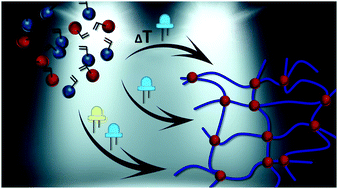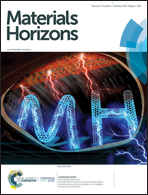Polymer networks based on photo-caged diene dimerization†
Abstract
A powerful, simple and efficient method for photochemical crosslinking, exploiting the self-dimerization of photo-caged dienes based on o-methylbenzaldehydes (o-MBAs) is introduced. Using a small molecule model system it is possible to identify the intermediate and final products of this light induced dimerization process. The bi-functional photocurable monomers contain o-MBA as well as vinylic units, which enables radical copolymerization with other monomers to tune the mechanical properties of the resulting networks. Crosslinked materials with reduced E-moduli ranging from 0.29 to 5.76 GPa and a hardness between 52 and 329 MPa were obtained, thus spanning a wide regime of different ‘soft’ to ‘hard’ material properties. The functional groups can be addressed through simultaneous reaction or in a λ-orthogonal fashion. This orthogonality can be achieved by inducing the free radical polymerization independently of the dimerization either thermally or via photoinitiation at a wavelength higher than the wavelength used for the non-radical dimerization process (>400 nm). Critically, this allows for a spatially defined adjustment of both the E-modulus and hardness within the respective material by controlling the irradiation parameters, such as wavelength, curing time and intensity. The introduced self-dimerizing resists thus represent a highly controllable combined radical/non-radical and λ-orthogonal curing system.



 Please wait while we load your content...
Please wait while we load your content...